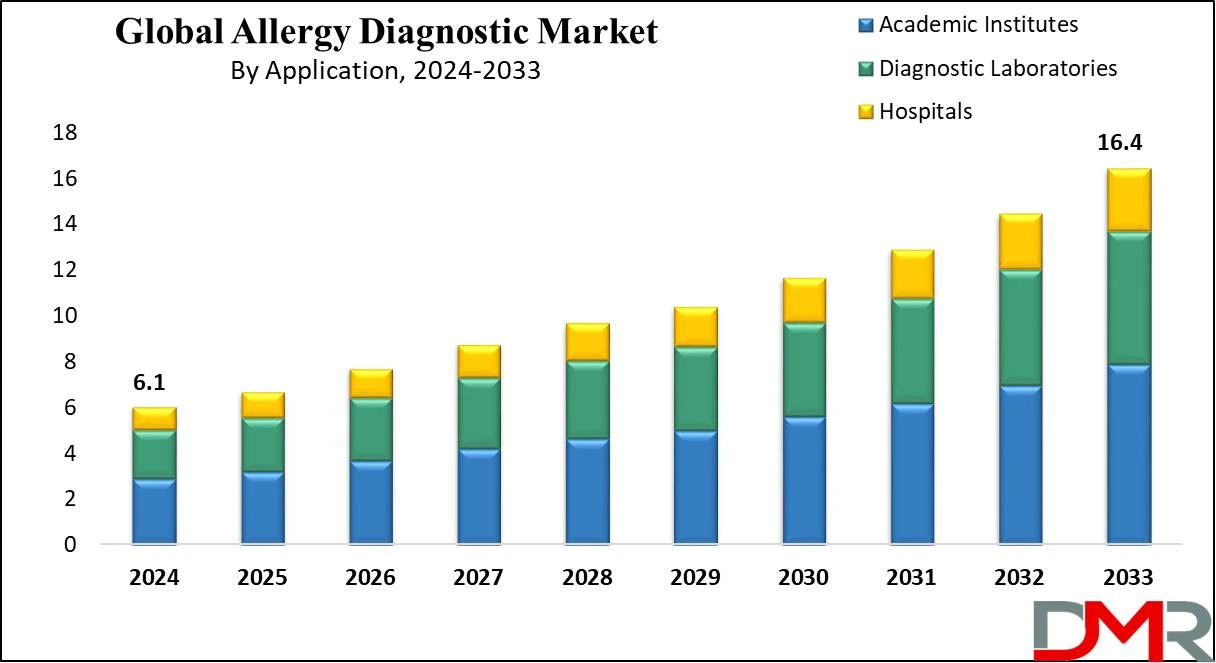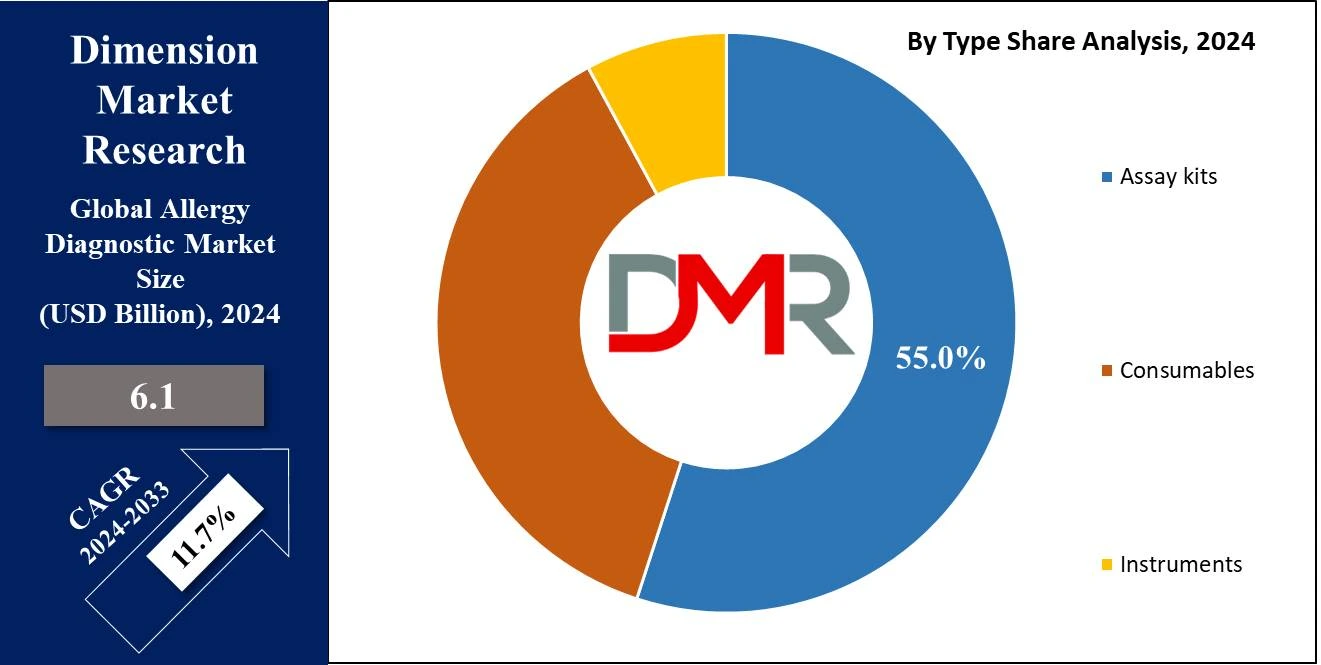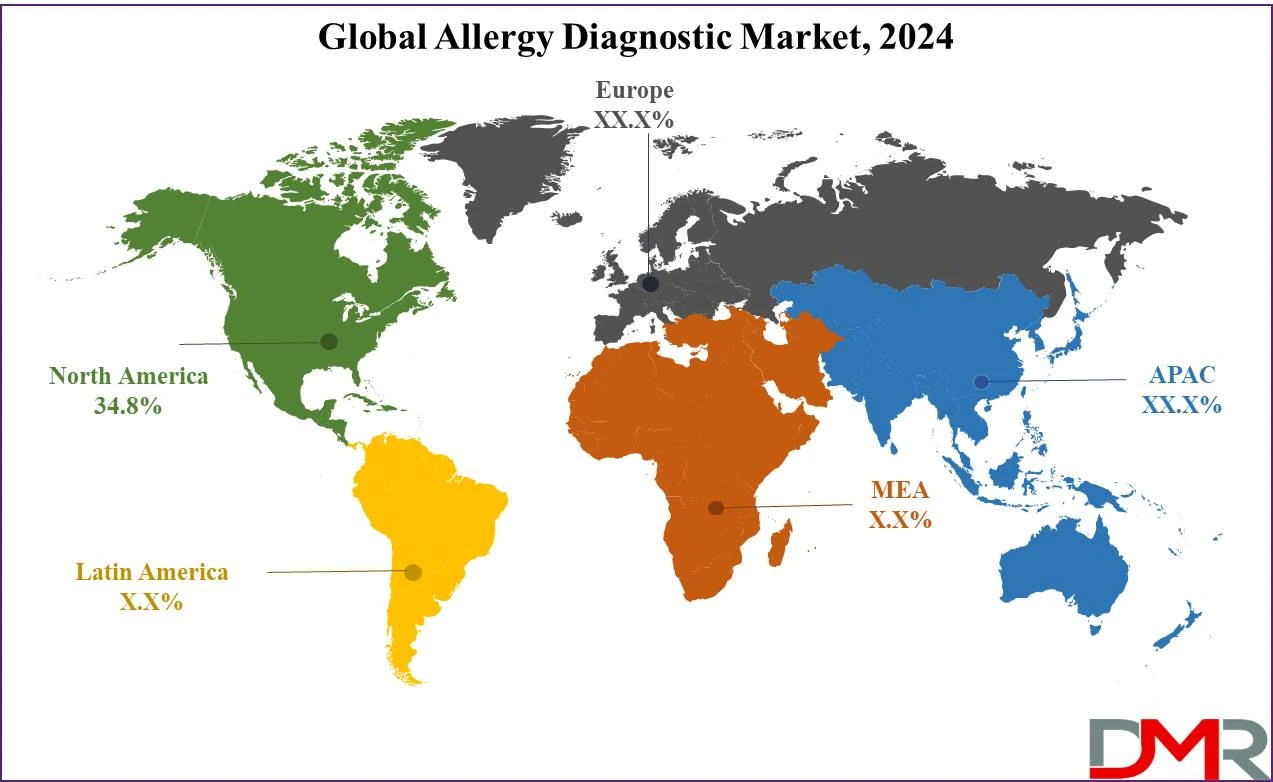Allergy Diagnostic Market Overview
Global Allergy Diagnostic Market size was valued at USD 6.1 Bn in 2024 and it is further anticipated to reach a market value of USD 16.4 Bn in 2033 at a CAGR of 11.7%.

Global Allergy Diagnostic Market report offers an in-depth analysis of the target market, encompassing factual data like market size and shares at both regional and country levels, with CAGR and year-on-year growth rates. The report gives crystal view on market trends, opportunities, restrains and challenges along with competitive landscape analysis. Porters Five Forces, PESTLE, supply-chain analysis, Ecosystem analysis and Macro economic factors are included to cover all the target market aspects.
The benefits associated with allergic disease diagnosis such as reliability in disease screening and reduced severity of disease with a better diagnosis & management are forecasted to positively impact the industry progress. Risk factors comprising dietary influences or food allergens, inhaled allergens and drug allergens among others are contributing to the allergic reactions significantly.
The research report on the global allergy diagnostic market includes both qualitative as well as quantitative analysis of the market, company profiles of major market players along with complete product details and their competitive scenario. The report highly exhibits on the current and upcoming market trends and provides comprehensive analysis of all the factors that impact the global allergy diagnostic market growth and size. The report will help companies to make better strategical business decisions.
Allergy Diagnostic Market Key Takeaways
- Market Size & Share: Allergy Diagnostic Market size was valued at USD 6.1 Bn in 2024 and it is further anticipated to reach a market value of USD 16.4 Bn in 2033 at a CAGR of 11.7%.
- Type Analysis: Assay kits dominated the Allergy Diagnostic Market in 2023, accounting for 55% of its market share.
- Application Analysis: Diagnostic Laboratories were the dominant application area within the Allergy Diagnostic Market in 2023, comprising approximately 48% of market share.
- Regional Analysis: North America secured the leading regional share in the Allergy Diagnostic Market with 34.8% in 2024.
Allergy Diagnostic Market Use Cases
- Clinical Diagnosis: Allergy diagnostic tests are used by healthcare professionals to identify specific allergens causing reactions in patients. This helps in tailoring personalized treatment plans and improving patient outcomes.
- Screening Programs: These diagnostics are employed in public health screening programs to identify at-risk populations, particularly in areas with high prevalence of allergies. Early detection through such programs can lead to preventive measures and reduce the incidence of severe allergic reactions.
- Research and Development: Allergy diagnostics are crucial in research settings for studying the mechanisms of allergic reactions, developing new treatments, and testing the efficacy of potential allergy medications.
- Food Industry Compliance: The food industry uses allergy diagnostics to test for potential allergens in food products, ensuring compliance with regulatory standards and protecting consumers from allergic reactions.
- Environmental Testing: Allergy diagnostics are used to test environmental samples for allergens, such as pollen, mold, or dust mites. This helps in assessing and mitigating allergy risks in different environments, including homes, workplaces, and schools.
Allergy Diagnostic Market Dynamics
Driver
The primary force driving growth in the allergy diagnostic market is its rising prevalence globally, due to factors like urbanization, pollution, diet change and genetic predispositions that lead to asthma, rhinitis and food allergies. Due to this phenomenon there has been an increasing need for accurate and reliable diagnostic tools capable of accurately identifying allergens as well as providing appropriate treatment plans; healthcare providers are adopting advanced allergy diagnostic tools more frequently in order to enhance patient care, reduce severe reactions more efficiently and improve overall health outcomes - driving market growth further.
Trend
One major trend in allergy diagnostics today is the adoption of advanced technologies like molecular diagnostics and point-of-care testing, two forms of technology which offer greater precision when understanding allergic reactions. Molecular diagnostics enable identification of specific allergenic components for more in-depth analyses that allow personalized treatment plans and improved management of allergic diseases, while point-of-care testing has become popular due to its convenience, quick results, and timely diagnosis and intervention - making allergy diagnostics more efficient, accurate, and accessible than ever.
Restraint
A key barrier in the allergy diagnostic market is the high cost associated with advanced diagnostic tests and equipment, particularly for healthcare facilities in low and middle income countries. Furthermore, lack of standardised testing protocols and variable results hinder wide adoption of allergy diagnostics limiting market expansion in regions with limited healthcare infrastructure resources.
Opportunity
The allergy diagnostic market offers tremendous growth potential in emerging markets. Growing healthcare awareness, rising disposable incomes, and improved healthcare infrastructure in these regions create an ideal setting for adopting allergy diagnostics. Furthermore, there exists an opportunity for developing cost-effective and user-friendly diagnostic tools suitable for deployment in resource-constrained settings.
Telemedicine and digital health platforms present companies with opportunities to expand the reach of allergy diagnostics by providing remote consultations and tests. By investing in research and development for affordable, accessible, and accurate diagnostic solutions they may gain a competitive edge in the market.
The COVID-19 Pandemic & Recession: Impact on the Global Allergy Diagnostic Market:
Dimension Market Research has closely monitored the impact of COVID-19 and the recession on specific business segments, along with its short and long-term implications at both the global and regional levels. The initial outbreak of the COVID-19 pandemic caused unprecedented economic damage across numerous regions. The COVID-19 pandemic severely disrupted production, sales, and supply chain activities in developed as well as developing economies. Our report comprehensively covers the pre and post-COVID-19 impacts, along with an analysis of the recession's effects on the global allergy diagnostic market.
Allergy Diagnostic Market Research Scope and Analysis
Type Analysis
Assay kits dominated the Allergy Diagnostic Market in 2023, accounting for 55% of its market share. Assay kits' widespread adoption can be attributed to their extensive use in various diagnostic procedures, including allergy testing and molecular diagnostics. Assay kits play an essential role in detecting allergens within patient samples - thus serving as the cornerstone of allergy diagnostics. These machines are widely adopted within clinical settings due to their reliability, ease of use and accuracy in providing results.

Technological advances have also enhanced the sensitivity and specificity of allergy testing kits, cementing their status as the superior option. Consumables such as reagents and materials used in conjunction with assay kits also play a crucial role, though their market share lags behind that of instruments. Though instruments are essential in conducting tests, their higher costs and longer lifespan limit their share of the market share.
Application Analysis
Diagnostic Laboratories were the dominant application area within the Allergy Diagnostic Market in 2023, comprising approximately 48% of market share. This segment's leadership can be attributed to its increasing demand for highly specialized and precise allergy testing, an area in which diagnostic laboratories excel. These laboratories offer an array of allergy tests, from skin prick tests to advanced molecular diagnostics, that provide precise identification of allergens. Healthcare providers looking for accurate diagnostic results often opt for large volume test processors with high accuracy capabilities.
Hospitals, though also important players in allergy diagnosis, typically refer complex cases to laboratories due to their specialized equipment and expertise. Academic institutes may play a vital role in research and development for allergy diagnostics, yet have only a minor market share due to their emphasis on research as opposed to routine diagnostics. Diagnostic laboratories remain dominant market players due to their vital role in providing accurate diagnoses and treatments of allergic diseases.
Allergy Diagnostic Market Analysis and Research Scope:
We provide Comprehensive insights about the allergy diagnostic market along with crucial Key factors such as market size, market CAGR, market potential, recent developments, trends, opportunities, new technologies and innovations, recent product launches, restraints and market regulations. This report will help our clients immensely in getting an inside out view of the allergy diagnostic market by providing them with the complete information about the allergy diagnostic market and its prominent players with their competitive analysis and strategies.
The global allergy diagnostic market research report provides accurate estimations for the forecast period 2024 to 2033 based on in-depth research and analysis through rigorous compilation of exhaustive primary and secondary research data. The final data will be carried out after verifying the in-house research analysis by the key opinion leaders of the global allergy diagnostic market. Our triangulate research method minimizes error margin and gives holistic view on the report.
The Global Allergy Diagnostic Market Report is segmented on the basis of the following:
Type
- Assay kits
- Consumables
- Instruments
Application
- Academic Institutes
- Diagnostic Laboratories
- Hospitals
Geographical Segmentation of the Global Allergy Diagnostic Market:
North America secured the leading regional share in the Allergy Diagnostic Market with 34.8% in 2023, this success can be attributed to several key factors, including increasing allergies prevalence rates and supportive government initiatives within this developed area with substantial healthcare expenditure. Furthermore, an awareness of allergy treatments' potential advantages has led numerous U.S.-based companies to invest heavily in allergy diagnostic products and related drugs development efforts.

Region and Countries
North America
Europe
- Germany
- The U.K.
- France
- Italy
- Russia
- Spain
- Nordic
- Benelux
- Rest of Europe
Asia-Pacific
- China
- Japan
- South Korea
- India
- ANZ
- ASEAN
- Rest of Asia-Pacific
Latin America
- Brazil
- Mexico
- Argentina
- Colombia
- Rest of Latin America
Middle East & Africa
- Saudi Arabia
- UAE
- Israel
- South Africa
- Egypt
- Rest of MEA
The global allergy diagnostic market research report provides competitive examination analysis of the leading players including company description, SWOT analysis, and financial information, exhaustive product portfolio with specifications, key business areas, market share analysis, acquisitions and mergers, and key developments, etc.
Competitive Landscape:
The global allergy diagnostic market is highly fragmented due to the presence of several leading players. Prominent market players of the allergy diagnostic market are exhibiting a keen interest towards the emerging economies such as China, India, etc. to enhance their revenue generating opportunities. The major market players are continuously focusing on their product branding, marketing and expansion of R&D, to increase their customer base. Exhaustive key vendor analysis has been done to meet the ever-changing needs of our clients and provide them with a complete overview on the competitiveness of the global allergy diagnostic market.
Global Allergy Diagnostic Market Key Players:
- Alerchek
- bioMerieuxc
- Danaher
- DST
- Hitachi chemical Diagnostic
- HOB Biotech
- Hycor Biomedical
- Lincoln Diagnostics
- Omega Diagnostic
- Siemens Healthcare
- Stallergenes Greer
- Thermo Fisher Scientific
Recent Developments
- Advancements in Diagnostic Technologies: Advancements in diagnostic technologies have revolutionized allergy diagnostic markets. For instance, multiplex assays and microarray testing offer simultaneous detection of multiple allergens for improved diagnostic accuracy. With greater sensitivity and specificity than traditional assays and microarrays.
- At-Home Testing Kits: Following the COVID-19 pandemic, at-home allergy testing kits have experienced tremendous growth in popularity. Companies are developing more user-friendly and reliable diagnostic kits so patients can self-administer tests and get results without visiting healthcare facilities.
- Rising Priorities in Personalized Medicine: The recent rise of personalized medicine is having a significant effect on allergy diagnostics market. Customized allergy diagnostic tests that address an individual patient's unique genetic makeup and environmental exposures lead to more effective and targeted treatments plans that lead to improved results.
- Collaborations and Partnerships: Many companies have entered into collaborations and partnerships with one another to broaden their product offerings and geographic reach. Such collaborations often include the implementation of innovative technologies or the joint development of diagnostic solutions.
Report Details
| Report Characteristics |
| Market Size (2024) |
USD 6.1 Bn |
| Forecast Value (2033) |
USD 16.4 Bn |
| CAGR (2024-2033) |
11.7% |
| Historical Data |
2018 – 2023 |
| Forecast Data |
2024 – 2033 |
| Base Year |
2023 |
| Estimate Year |
2024 |
| Report Coverage |
Market Revenue Estimation, Market Dynamics, Competitive Landscape, Growth Factors and etc. |
| Segments Covered |
By Type (Assay kits, Consumables, Instruments) By Application (Academic Institutes, Diagnostic Laboratories, Hospitals) |
| Regional Coverage |
North America – The US and Canada; Europe – Germany, The UK, France, Russia, Spain, Italy, Benelux, Nordic, & Rest of Europe; Asia- Pacific– China, Japan, South Korea, India, ANZ, ASEAN, Rest of APAC; Latin America – Brazil, Mexico, Argentina, Colombia, Rest of Latin America; Middle East & Africa – Saudi Arabia, UAE, South Africa, Turkey, Egypt, Israel, & Rest of MEA
|
| Prominent Players |
Alerchek, bioMerieuxc, Danaher, DST, Hitachi chemical Diagnostic, HOB Biotech, Hycor Biomedical, Lincoln Diagnostics, Omega Diagnostic, Siemens Healthcare, Stallergenes Greer, Thermo Fisher Scientific |
| Purchase Options |
We have three licenses to opt for: Single User License (Limited to 1 user), Multi-User License (Up to 5 Users), and Corporate Use License (Unlimited User) along with free report customization equivalent to 0 analyst working days, 3 analysts working days and 5 analysts working days respectively. |